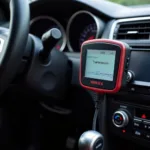OBD2 scanners have become essential tools for vehicle diagnostics, offering a window into your car’s inner workings. Among the wealth of data these scanners provide, live data for the Anti-lock Braking System (ABS) stands out as crucial for both car owners and mechanics. This data stream can pinpoint ABS issues, saving you time and potentially costly repairs.
Deciphering the Value of ABS Live Data
Accessing live data from your vehicle’s ABS module via an OBD2 scanner provides real-time insights into the system’s performance. This goes beyond simply reading error codes; it’s like having a direct line to your car’s brain, specifically for braking.
Here’s why this data is so valuable:
-
Early Problem Detection: Live data can reveal subtle anomalies in your ABS system before they escalate into major problems or trigger the dreaded check engine light. This proactive approach can save you from dangerous braking situations down the road.
-
Targeted Troubleshooting: Instead of relying on guesswork, mechanics can use ABS live data to pinpoint the root cause of an issue. Whether it’s a faulty wheel speed sensor, a malfunctioning ABS module, or a simple wiring problem, live data streamlines the diagnostic process.
-
Informed Repair Decisions: By understanding the precise nature of an ABS problem through live data, car owners can make informed decisions about repairs. This transparency can prevent unnecessary part replacements and ensure you only pay for what’s truly needed.
Key ABS Parameters to Monitor
Navigating the world of ABS live data can seem daunting, but focusing on a few key parameters can provide a wealth of information. Here are some of the most important ones:
1. Wheel Speed Sensor Data
These sensors, typically located at each wheel, are the backbone of your ABS system. They constantly measure wheel rotation speed, sending data to the ABS module.
What to look for: Consistent readings across all four sensors are crucial. Any significant discrepancies can indicate a faulty sensor, wiring issue, or even a problem with the wheel bearing itself.
2. Brake Pedal Position
This parameter indicates how far the brake pedal is depressed. The ABS module uses this information, along with wheel speed data, to determine if and when to activate the ABS.
What to look for: The live data should accurately reflect the position of your brake pedal. Any lag or erratic readings could point to a problem with the brake pedal position sensor.
3. ABS Module Status
The ABS module is the brain of the system, processing data and controlling the ABS valves. Its live data status provides an overview of its operational condition.
What to look for: A “normal” or “active” status generally indicates the module is functioning correctly. Any other status, such as “fault” or “inactive,” warrants further investigation as it suggests a problem within the module itself.
Choosing the Right OBD2 Scanner for ABS Live Data
Not all OBD2 scanners are created equal. To access the full potential of ABS live data, you’ll need a scanner with specific capabilities:
-
Live Data Streaming: Ensure the scanner you choose explicitly states its ability to read and display live data streams.
-
ABS Compatibility: While most modern scanners can access basic OBD2 data, verify that the scanner explicitly supports enhanced diagnostics for the ABS system of your specific car make and model.
-
Data Logging: For in-depth analysis, consider a scanner with data logging capabilities. This allows you to record live data during a test drive, providing valuable information to diagnose intermittent problems.
Conclusion: ABS Live Data – A Powerful Tool for Safer Braking
Understanding and utilizing OBD2 scanner live data, particularly for your ABS system, empowers you to maintain a safer and more reliable vehicle. Whether you’re a car enthusiast or simply want to stay ahead of potential braking issues, investing in a quality OBD2 scanner and learning to interpret its data is a smart move.
FAQs About OBD2 Scanners and ABS Live Data
1. Can any OBD2 scanner read ABS live data?
No, not all OBD2 scanners can access ABS live data. Look for scanners specifically advertising this feature and compatibility with your vehicle’s make and model.
2. Do I need a mechanic to interpret ABS live data?
While basic understanding can be helpful, interpreting ABS live data accurately often requires specialized knowledge. Mechanics use this data to pinpoint issues efficiently.
3. What are common problems detected through ABS live data?
Common problems include faulty wheel speed sensors, malfunctioning ABS modules, brake pedal position sensor issues, and wiring problems within the system.
4. Can I use ABS live data to monitor my braking performance?
While not designed for performance monitoring, ABS live data can provide insights into braking behavior, such as wheel lockup during hard stops, which can be helpful for understanding your car’s braking characteristics.
5. How often should I check my ABS system with an OBD2 scanner?
It’s generally recommended to check your car’s systems, including the ABS, annually or whenever you suspect a problem.
Need More Information?
For further assistance with OBD2 scanners, diagnostic trouble codes, or any automotive concerns, feel free to explore these resources:
- OBD2 Scanner Symbols
- ELM327 OBD2 Reader Wifi App
- Best Rated OBD2 Scanners
- Centech OBD2 Codes
- NipponPower OBD2
Have questions or need immediate assistance? Contact our 24/7 support team via WhatsApp: +1(641)206-8880 or Email: [email protected]. We’re here to help!


